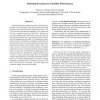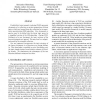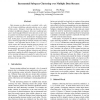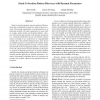ICDM
2007
IEEE
14 years 5 months ago
2007
IEEE
We address a new learning problem where the goal is to build a predictive model that minimizes prediction time (the time taken to make a prediction) subject to a constraint on mod...
ICDM
2007
IEEE
14 years 5 months ago
2007
IEEE
Frequent failures are becoming a serious concern to the community of high-end computing, especially when the applications and the underlying systems rapidly grow in size and compl...
ICDM
2007
IEEE
14 years 5 months ago
2007
IEEE
The problem of evaluating scientific publications and their authors is important, and as such has attracted increasing attention. Recent graph-theoretic ranking approaches have d...
ICDM
2007
IEEE
14 years 5 months ago
2007
IEEE
ICDM
2007
IEEE
14 years 5 months ago
2007
IEEE
Learning communities from a graph is an important problem in many domains. Different types of communities can be generalized as link-pattern based communities. In this paper, we p...
ICDM
2007
IEEE
14 years 5 months ago
2007
IEEE
Probabilistic latent semantic indexing (PLSI) represents documents of a collection as mixture proportions of latent topics, which are learned from the collection by an expectation...
ICDM
2007
IEEE
14 years 5 months ago
2007
IEEE
Data streams are often locally correlated, with a subset of streams exhibiting coherent patterns over a subset of time points. Subspace clustering can discover clusters of objects...
ICDM
2007
IEEE
14 years 5 months ago
2007
IEEE
Zonal co-location patterns represent subsets of featuretypes that are frequently located in a subset of space (i.e., zone). Discovering zonal spatial co-location patterns is an im...
ICDM
2007
IEEE
14 years 5 months ago
2007
IEEE
Documents and authors can be clustered into “knowledge communities” based on the overlap in the papers they cite. We introduce a new clustering algorithm, Streemer, which fin...
ICDM
2007
IEEE
14 years 5 months ago
2007
IEEE
Support vector clustering transforms the data into a high dimensional feature space, where a decision function is computed. In the original space, the function outlines the bounda...




